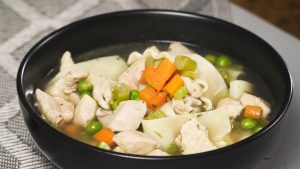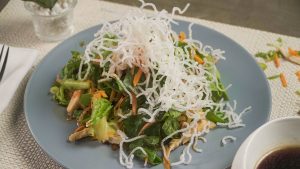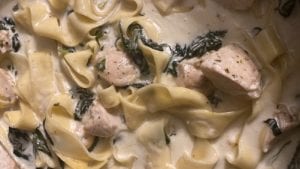Savor the umami flavors of the Far East with this delightful Miso Noodle Soup. Packed with nutritious ingredients like tofu, fresh vegetables, and soba noodles, it's a comforting bowl of wholesomeness. The star of this meal is the miso paste, which adds depth and richness to the broth, making it a delightful dish for any season.
Miso paste and soba noodles might not be in your regular grocery list, but these are crucial for this recipe. Miso, a traditional Japanese ingredient, is a fermented soybean paste that adds a rich, savory flavor to dishes. Soba noodles are thin, brown noodles made from buckwheat, known for their nutty flavor and smooth texture. Both can be found in the international aisle of most supermarkets or Asian grocery stores.
Miso Noodle Soup Essential Ingredients
Vegetable broth: Forms the base of the soup, providing plenty of flavors.
Soba noodles: Thin Japanese noodles made from buckwheat flour, they provide a unique, nutty flavor and a lovely texture.
Tofu: Adds a good source of plant-based protein to the soup.
Red bell pepper: Gives the dish a pop of color and a crisp, sweet flavor.
Green onions: Adds a sharp, fresh flavor to the soup.
White miso: A fermented soybean paste that gives the soup its unique, deep flavor.
Fresh ginger: Brings a warm, spicy aroma to the dish.
Red pepper: Adds a touch of heat to the soup.
Snow peas: Brings a fresh, sweet crunch to the soup.
Carrot: Adds color, sweetness, and a bit of crunch.
Red pepper flakes: Provides a little kick of heat.
Sriracha: A hot sauce for an extra layer of heat and flavor.
One reader, Edan Galloway says:





This miso noodle soup recipe is a game-changer! The flavors are so rich and comforting. The combination of miso, ginger, and tofu creates a perfect balance. The addition of sriracha gives it a nice kick. It's a go-to for a quick, satisfying meal. Highly recommend trying it out!
Techniques Required for Making Miso Noodle Soup
How to prepare the miso noodle soup: This technique involves combining the vegetable broth and water in a large saucepan and bringing it to a boil before adding the other ingredients.
How to simmer the soup: Simmering the soup allows the flavors to meld together and the ingredients to cook through, creating a delicious and well-balanced dish.
How to garnish the soup: Garnishing the soup with additional crushed red pepper and a light drizzle of sriracha adds a pop of color and extra flavor to the dish.
How to serve the miso noodle soup: Serving the soup in bowls and enjoying it while it's hot ensures that the flavors and textures are at their best.
How To Make Miso Noodle Soup
Try this authentic Japanese noodle soup for lunch today! It comes with salty miso, tofu and chewy soba noodles for a more belly-filling meal.
Serves:
Ingredients
- 4cupsvegetable broth
- ½cupwater
- 3ozsoba noodles,broken in half
- 14oztofu,1 containter, extra-firm, drained and sliced into small, bite-sized pieces
- 1red bell pepper,medium, sliced into bite-sized strips
- ⅓cupgreen onions,sliced
- 1tbspwhite miso
- 1tbspfresh ginger,grated
- ⅛tspred pepper,crushed
- 1cupfresh snow peas,halved crosswise
- 1carrot,peeled and ribboned
- red pepper flakes ,optional
- sriracha,optional
Instructions
-
In a large saucepan, combine the broth and water then bring the mixture to a boil.
-
Add the soba noodles and return to a boil, then reduce heat, cover and simmer for 5 minutes.
-
Stir in the tofu, bell pepper, onions, miso, ginger, and the crushed red pepper.
-
Simmer, covered, for 3 minutes.
-
Stir in the halved snow peas and carrot ribbons.
-
Simmer, uncovered, for 1 minute more or until the peas are crisp-tender.
-
Ladle soup into bowls and garnish with additional crushed red pepper and a light drizzle of sriracha.
-
Serve, and enjoy!
Nutrition
- Calories: 120.80kcal
- Fat: 3.22g
- Saturated Fat: 0.65g
- Monounsaturated Fat: 0.92g
- Polyunsaturated Fat: 1.36g
- Carbohydrates: 16.67g
- Fiber: 2.10g
- Sugar: 2.77g
- Protein: 8.70g
- Sodium: 260.06mg
- Calcium: 161.95mg
- Potassium: 273.67mg
- Iron: 2.10mg
- Vitamin A: 133.10µg
- Vitamin C: 37.46mg
Crucial Technique Tips for Perfecting Miso Noodle Soup
When preparing the tofu, it's best to press it before adding it to the soup. This will remove excess water and allow the tofu to absorb more of the flavorful broth. To press tofu, wrap it in a clean kitchen towel or paper towels, place it on a flat surface, and put a heavy object on top, like a skillet or a cutting board weighed down with cans. Let it sit for about 15 minutes before cutting it into cubes and adding it to the soup. This will enhance the overall taste of your miso noodle soup.
Time-Saving Tips for Preparing Miso Noodle Soup
Prep ahead: Chop and prepare ingredients in advance to streamline the cooking process.
One-pot wonders: Opt for recipes that require minimal dishes and cooking utensils for easy cleanup.
Batch cooking: Make larger quantities and freeze leftovers for quick and convenient future meals.
Organized workspace: Keep your kitchen tidy and organized to save time searching for ingredients and utensils.
Time-saving gadgets: Utilize kitchen tools like food processors and slow cookers to simplify meal preparation.
Efficient multitasking: Plan and execute tasks simultaneously to maximize productivity in the kitchen.
Substitute Ingredients For Miso Noodle Soup Recipe
vegetable broth - Substitute with mushroom broth: Mushroom broth adds a rich, earthy flavor that can enhance the umami taste of the soup.
soba noodles - Substitute with rice noodles: Rice noodles are a gluten-free alternative and will work well in the soup, providing a similar texture and absorbing the flavors of the broth.
tofu - Substitute with tempeh: Tempeh has a firmer texture and a nutty flavor that can add a different dimension to the soup.
white miso - Substitute with red miso: Red miso has a stronger, more robust flavor that can add depth to the soup.
fresh ginger - Substitute with ground ginger: Ground ginger can be used as a substitute in a pinch and will still provide the warm, aromatic flavor to the soup.
snow peas - Substitute with snap peas: Snap peas have a similar crunch and sweetness, making them a suitable substitute in the soup.
sriracha - Substitute with chili garlic sauce: Chili garlic sauce can provide a similar spicy kick and garlicky flavor to the soup.
Presentation Tips for Miso Noodle Soup
Elevate the plating: Carefully arrange the tofu, bell pepper, and snow peas in an artful and visually appealing manner. The presentation should be clean and sophisticated, with each ingredient thoughtfully placed to showcase the beauty of the dish.
Incorporate contrasting colors: Utilize the vibrant colors of the red bell pepper, green onions, and snow peas to create a visually striking presentation. The colorful array of ingredients will add depth and visual interest to the dish.
Emphasize texture: Highlight the varying textures of the ingredients by ensuring that the tofu is firm and well-drained, the snow peas are crisp, and the soba noodles are perfectly cooked. This will create a delightful textural experience for the diners.
Garnish with precision: Add a sprinkle of red pepper flakes with precision, ensuring they are evenly distributed for a pop of color and flavor. A light drizzle of sriracha can be added in a controlled manner to enhance the visual appeal and provide a hint of heat.
Use elegant serving bowls: Select elegant, high-quality serving bowls that complement the colors of the soup and enhance the overall presentation. The bowls should be clean and free from any smudges or marks.
Attention to detail: Pay close attention to the final presentation, ensuring that the soup is free from any spills or smudges on the rim of the bowl. The presentation should exude professionalism and attention to detail, reflecting the standards of a Michelin-starred establishment.
Balance and symmetry: Strive for balance and symmetry in the placement of ingredients within the bowl. The arrangement should be visually appealing and harmonious, creating a sense of balance and order in the presentation.
Storing and Freezing Miso Noodle Soup
Allow the miso noodle soup to cool completely before storing or freezing. This will prevent the noodles from becoming soggy and overcooked.
For short-term storage, transfer the cooled soup to an airtight container and refrigerate for up to 3-4 days. The flavors will meld together, making the soup even more delicious the next day.
If you plan to freeze the soup, consider the following steps:
- Cook the soba noodles slightly less than al dente, as they will soften further upon reheating.
- Separate the noodles from the broth and store them in a separate airtight container or freezer bag. This will prevent the noodles from absorbing too much liquid and becoming mushy.
- Store the tofu, vegetables, and broth in a freezer-safe container or freezer bag, leaving some room at the top for expansion.
- Label the containers with the date and contents for easy reference.
- Freeze the soup components for up to 2-3 months.
When ready to serve the frozen soup:
- Thaw the broth and vegetables in the refrigerator overnight.
- Reheat the broth and vegetables in a saucepan over medium heat until simmering.
- Cook the frozen noodles in a separate pot of boiling water for 1-2 minutes, or until heated through.
- Combine the reheated broth, vegetables, and noodles in serving bowls.
- Garnish with fresh green onions, red pepper flakes, and a drizzle of sriracha before serving.
How To Reheat Miso Noodle Soup Leftovers
Reheat the miso noodle soup in a pot on the stove over medium heat, stirring occasionally until it reaches the desired temperature. This method ensures even heating and allows the flavors to meld together again.
If you prefer a quicker method, you can reheat the soup in the microwave. Transfer the desired portion to a microwave-safe bowl and heat it in 30-second intervals, stirring between each interval, until it's heated through. Be careful not to overheat the soup, as it may cause the noodles to become mushy.
For a fresher taste, you can separate the noodles and vegetables from the broth before storing the leftovers. When reheating, warm up the broth in a pot or microwave, and then add the noodles and vegetables, cooking until they're heated through. This method prevents the noodles from becoming overcooked and maintains the texture of the vegetables.
If the soup has thickened after being stored in the refrigerator, you can thin it out by adding a little water or vegetable broth while reheating. This will help restore the original consistency of the soup.
To enhance the flavor of the reheated soup, consider adding a fresh squeeze of lime juice, a sprinkle of chopped green onions, or a dash of sriracha before serving. These additions can brighten up the flavors and make the soup taste as good as new.
Interesting Facts About Miso Noodle Soup
The miso noodle soup recipe is a popular dish in Japanese cuisine and is known for its umami flavor. Miso, a traditional Japanese seasoning, is made from fermented soybeans and adds a unique depth of flavor to the soup. It is also a good source of probiotics and nutrients.
Is Making Miso Noodle Soup at Home Cost-Effective?
This miso noodle soup recipe is quite cost-effective for a household. The ingredients, such as tofu, vegetable broth, and soba noodles, are reasonably priced and can be found in most grocery stores. The addition of fresh vegetables like bell peppers, snow peas, and carrots adds nutritional value without breaking the bank. The total cost for a household of 4 people is approximately $15. Overall, this recipe offers a delicious and budget-friendly option for a satisfying meal. Verdict: 9.
Is Miso Noodle Soup Healthy?
This miso noodle soup recipe is a healthy and nutritious option. Here's why:
- The soup is packed with vegetables like red bell pepper, green onions, snow peas, and carrots, providing essential vitamins, minerals, and fiber.
- Tofu is a great source of plant-based protein, which is low in fat and cholesterol-free.
- Soba noodles, made from buckwheat, are a healthier alternative to regular wheat noodles. They are rich in fiber and contain essential nutrients like manganese and thiamin.
- Miso, a fermented soybean paste, is a good source of probiotics, which can improve gut health and boost immunity.
- Ginger has anti-inflammatory properties and can aid in digestion.
- The recipe uses vegetable broth, which is lower in sodium compared to regular chicken or beef broth.
To make this recipe even healthier:
- Use low-sodium vegetable broth to reduce the overall sodium content of the soup.
- Increase the amount of vegetables in the soup, such as adding mushrooms, bok choy, or spinach, to boost the nutrient content and fiber.
- Opt for organic tofu to avoid any potential GMOs or pesticide residues.
- Use whole grain soba noodles to increase the fiber content of the dish.
- Add a squeeze of fresh lemon juice before serving to enhance the flavors and provide a dose of vitamin C.
- Garnish with fresh herbs like cilantro or Thai basil for added flavor and nutrients.
Editor's Opinion on This Miso Soup Recipe
This miso noodle soup recipe is a delightful combination of flavors and textures. The use of miso adds a depth of umami, while the fresh ginger and red pepper provide a subtle heat. The addition of tofu, snow peas, and carrots brings a satisfying crunch to the dish. The recipe is well-balanced and offers a comforting and nourishing meal. It's a perfect choice for anyone looking for a healthy and flavorful soup option.
Enhance Your Miso Noodle Soup Recipe with These Unique Side Dishes:
Similar Recipes to Try If You Love Miso Noodle Soup
Appetizer and Dessert Pairings for Miso Noodle Soup
Why trust this Miso Noodle Soup Recipe:
This #food# recipe offers a delightful combination of flavors and textures, making it a #food# lover's dream. The use of miso adds a rich umami depth, while the tofu provides a satisfying protein boost. The inclusion of ginger and red pepper adds a subtle heat, and the fresh snow peas and carrot ribbons bring a delightful crunch. With the aromatic green onions and a touch of sriracha, this #recipe# promises to tantalize the taste buds and bring a burst of #food# excitement to your table.
Was this page helpful?
Have your own special recipe to share? Submit Your Recipe Today!












